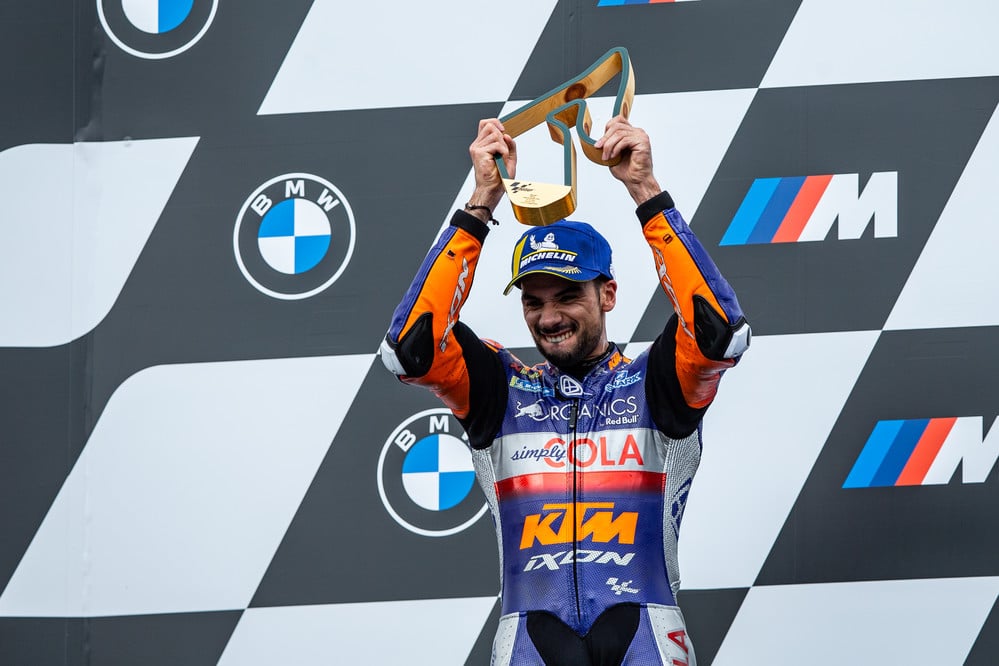
MotoGP: Oliveira, Tech 3 Score Maiden Win in Styrian Classic
MotoGP has gotten into a habit of offering up a substantial amount of drama in each race in 2020, and the Styrian Grand Prix – round five of the season – was no different.
Pol Espargaro started from his first pole position, but with two holeshot device-equipped riders alongside him on the front row, it was perhaps no surprise to see him beaten to turn one. The Spaniard came out of turn one third, behind Joan Mir and Jack Miller.
Mir would not lead for long, though, as a penalty for running wide on the exit of turn one – a penalty applied inconsistently, to say the least, when looking at the rest of the field – would see him drop behind Jack Miller.
Mir regained the lead on lap four, and with clear track the Suzuki was able to exploit its corner speed advantage. The #36 started to stretch the pack out, and soon he was part of a three-way fight for the lead, with Miller and Takaaki Nakagami close behind.
However, whilst Miller and Nakagami were close, they were never able to challenge the Spaniard directly. The Suzuki picks up well out of the corner, so it pulls metres on its rivals in the first part of the straight, meaning the faster bikes have to chase it down once they’ve planted their superior horsepower. Not only that, but the GSX-RR stops well, and Mir’s aggressive braking style is able to exploit this strength of the bike.
As the race approached half distance, Miller’s pace began to drop. He couldn’t live with Mir’s speed, and Nakagami sensed it. He made his move on lap 15 for second place, and set his sights on Mir, who by this point was close to two seconds clear out front.
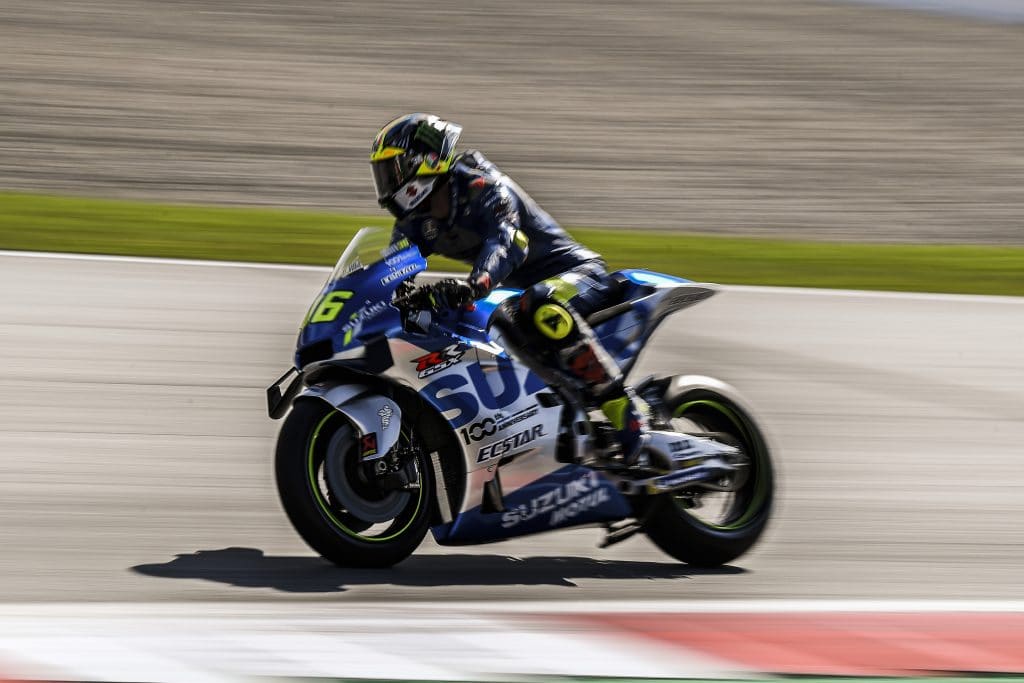
A red flag, however, stopped Mir in his tracks. It was unfortunate for the Spaniard, who had dominated the race up to lap 16, leading 13 of those laps.
The stoppage was caused by a dramatic incident or Maverick Vinales, who could have done without it after his scare at turn three last weekend. The Spaniard, on approach to turn one, was forced to jump off his bike at 200km/h courtesy of a brake failure. And, as brake failures go, this one was quite spectacular, with pieces of the caliper falling off the #12 M1 along the front straight.
Yamaha had been the only manufacturer running the lower-mass brake calipers this weekend, whilst the rest of the field had been running the high-mass caliper. On the way into the pits after the red flag was thrown, Fabio Quartararo gestured to Valentino Rossi to ask the Italian how his brakes felt, indicating concerns of his own. Rossi’s gesture back was not especially encouraging, suggesting the #46, too, was suffering with brake wear.
For Quartararo, of course, it had been braking issues that cost him in the Austrian Grand Prix last week, and which had seen him run long throughout the weekend of the Styrian Grand Prix, including in the race. It seems that Yamaha’s desire to stick with the low-mass caliper was a mistake, and for Vinales the consequences were severe, although his quick reactions prevented a far worse outcome.
Of course, without a pilot, Vinales’ YZR-M1 hurtled towards the barrier unchecked, pierced the air fence and caught fire. To add proverbial salt in the proverbial wound, it therefore looks like Vinales has lost a second engine for the season, leaving him with three – already opened – engines to complete the remaining nine races of 2020.
Whilst the red flag was bad for people like Joan Mir and Takaaki Nakagami, it was positive for Pol Espargaro and Andrea Dovizioso, who suffered in the first start, as well as Johann Zarco, who had to start the original race from pit lane. Espargaro had nothing like the pace he displayed last weekend in the first start, and Dovizioso likewise. They both, then, had a chance at redemption in the restart.
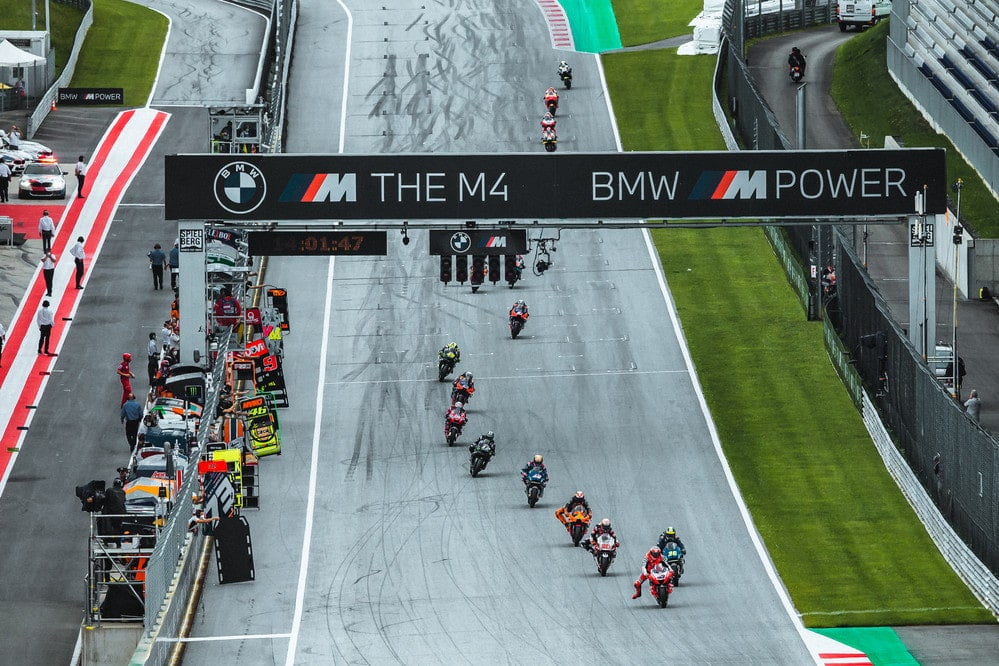
The red flag also presented an opportunity, that to change tyres. Ultimately, this would be pivotal for the outcome of the race, as some riders were advantaged and others disadvantaged by this. For some riders, like Joan Mir and Takaaki Nakagami, the opportunity to change tyres was a disaster because they had no tyres left, so had to restart with the tyres they finished the ‘first race’ with. On the contrary, for riders like Andrea Dovizioso and Pol Espargaro, who struggled in the first start, it was an advantage because they could do away with tyres that did not work for them. Additionally, for Miguel Oliveira, there was an opportunity to swap the medium front tyre for a hard front tyre, the Portuguese having regretted the decision to go a step softer since the beginning of the first race.
This transformed the race. Whilst Joan Mir made the holeshot, proving the effectiveness of Suzuki’s holeshot device, Jack Miller was able to pass him quickly. Unlike in the first race, where Mir was able to respond to Miller, this time he instead dropped further back, first behind Pol Espargaro, then Miguel Oliveira, and then Andrea Dovizioso.
For Nakagami, who was nailed on for a maiden MotoGP podium in the first start, the situation was worse, as he could not hold onto the pace of the leading five.
Although Dovizioso had moved into fourth place, he was unable to make much of an impression on the top three in the closing stages of the 12-lap sprint that came after the red flag. The Italian was not fast enough on corner exit to prepare an overtake, which if anything is a compliment to the KTM ahead of him, that of Oliveira.
However, Dovizioso knew the importance of taking strong points from Austria, and so tried to get close enough to pass the Portuguese rider on the final lap. In doing so, however, he ran wide at turn three, and lose fourth place again to Mir.
This left three at the front – Espargaro, who had been leading since lap seven and had something approaching a gap to Miller in second place as they went onto the final lap, whilst Oliveira was putting pressure on the Australian.
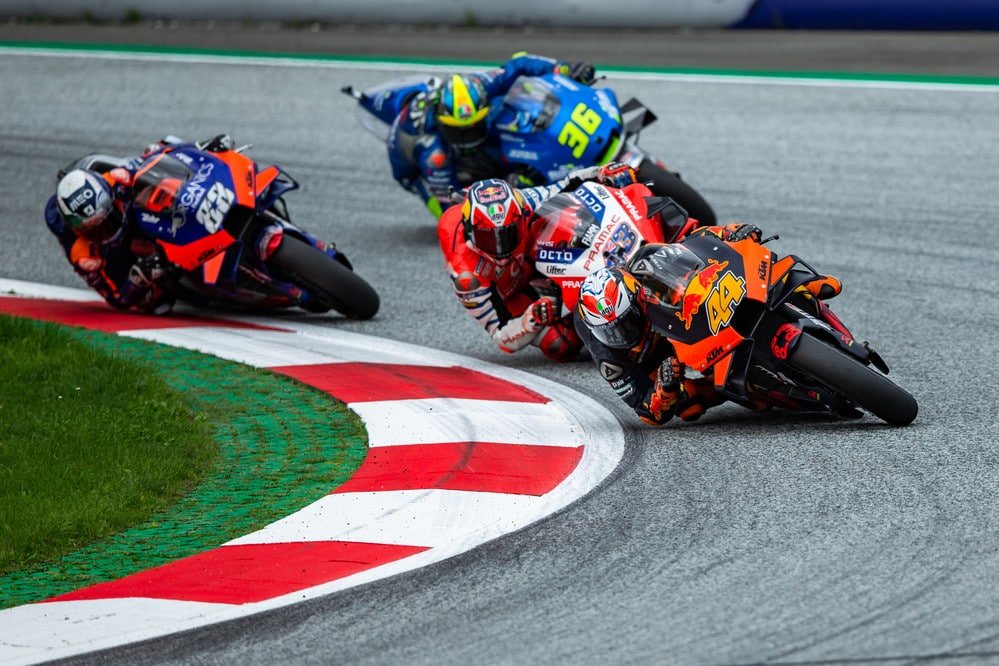
Espargaro’s pit board read ‘+0’ over the line to start the final lap, and as Neil Hodgson pointed out in commentary for BT Sport, that spelled disaster for the Spaniard who went unnecessarily defensive into turn three. Espargaro braked off the line, off the rubber, and therefore did not decelerate as effectively as those behind, who closed in. The #44 missed the apex at turn three, ran wide on the exit, was late to pick the bike up and get back to the throttle, and did so with less momentum.
Espargaro’s run to turn four was ruined, whilst Miller’s was perfect, having taken a wide approach into turn three, using his ‘Scandinavian flick’ technique in that corner to combat the Ducati’s inherent understeer, carry good mid-corner speed and square the corner off nicely. The #43 was able to draw alongside Espargaro under braking for turn four, blocked the line at the apex, and got a good enough run out of the corner so as to not allow Espargaro to retaliate at turn five.
The factory KTM rider was not done, though, and his strongest point was yet to come. Whilst the Ducati of Miller struggled to turn in the long left-handers of turns six and seven, Espargaro’s more agile KTM drew the Desmosedici in. Then, through the crucial traction zone of turn eight – where the balance between spin and traction must be perfect to both complete the corner and maximise the exit speed for the run to turn nine – Espargaro took yards out of Miller’s advantage and was able to line up for a pass at the penultimate corner.
Miller, though, read the situation well and, although Espargaro did not run wide by much at the apex at turn nine, the Pramac Ducati rider found a way underneath his rival, and was able to level him on braking for the final turn.
However, as we saw in the past with Francesco Bagnaia and Miguel Oliveira in the 2018 Moto2 race, and with Andrea Dovizioso and Marc Marquez in the 2017 and 2019 MotoGP races, a move at turn 10 is almost certain to end with someone running off-track, and both riders missing the corner.
On this occasion, it was Espargaro who ran off-track, but whilst Miller was able to keep the #43 Ducati in track limits, he was unable to get back to the throttle quick enough to stop Oliveira coming through on the inside, the Portuguese seizing the lead at the vital moment to take his maiden MotoGP victory.
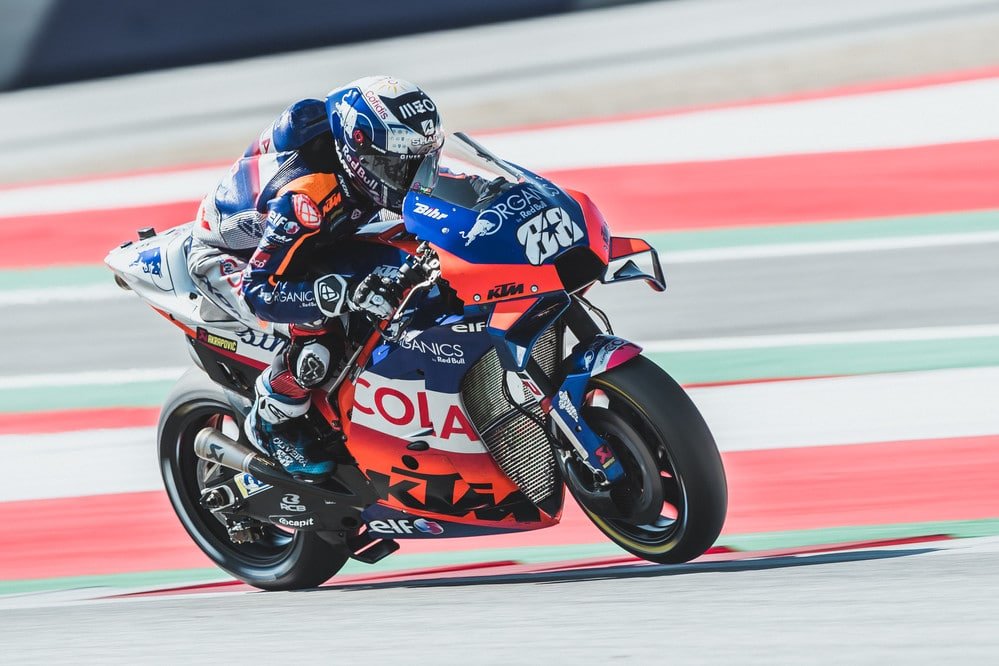
It was a first MotoGP win not only for Oliveira, but also for Portugal and the Tech 3 team, and it was won through intelligence and experience. Oliveira had already lost out in a last corner battle at Austria, with Francesco Bagnaia in the 2018 Moto2 race when the Italian passed him on the inside, just as Miller did to Espargaro on this occasion. This time, Oliveira knew Miller would try to pass Espargaro on the inside, and that Espargaro would either run wide or try to square him off. When he saw Espargaro trying to hold it round the outside of the Australian, Oliveira sensed his opportunity, and took it convincingly.
Despite Miller’s failed attempt at winning the race, he did the only thing he could in the situation. The only way he could win the race was to pass Espargaro in the final corner, a drag race to the line would not have worked in his favour. Oliveira coming through on the exit of the corner was unfortunate for Miller, but taking second place having done everything he could to win is easier to take than a second place for which he had settled.
Perhaps the only rider of the top three who could have regrets about the final lap was Espargaro. If he did not defend into turn three he probably would have won. However, the threat from Miller behind was substantial, or at least that is what he was told, and so he had little choice, in reality. The second mistake of the #44 was in the final corner, when trying to square Miller off might have worked to his advantage rather than going around the outside. However, it is true that Miller blocked the line well, and left Espargaro with little option. It was Espargaro’s second podium in the MotoGP class, after the third place in Valencia 2018, and surely the win is not far away.
Joan Mir managed to pick off Andrea Dovizioso on the final lap, when the Italian ran wide in turn three. The Spaniard did well, in reality, to take 13 points for fourth place considering his tyre situation in the second start, but was angry to not have been promoted to the podium after the race. This was because when Espargaro ran wide onto the green paint on the outside of the track in the final corner, he opened the throttle and powered to the line.
Earlier in the day, Jorge Martin had been penalised one position, costing him the Moto2 race win, for running onto the green paint off the end of the kerb on the exit of turn eight. Espargaro’s offence was arguably more severe than Martin’s, and yet he got away without a sanction. Whilst it is true that Espargaro had nowhere to go but off the track in the final corner due to the presence of Miller, it is also true that he used the asphalt run-off to his advantage, which is the reason for the existence of the rule for which Martin was penalised in the Moto2 race; that is to stop riders from gaining an advantage in defending or gaining a position in the final lap of a race, if they haven’t yet been issued with a track limits warning in the race.
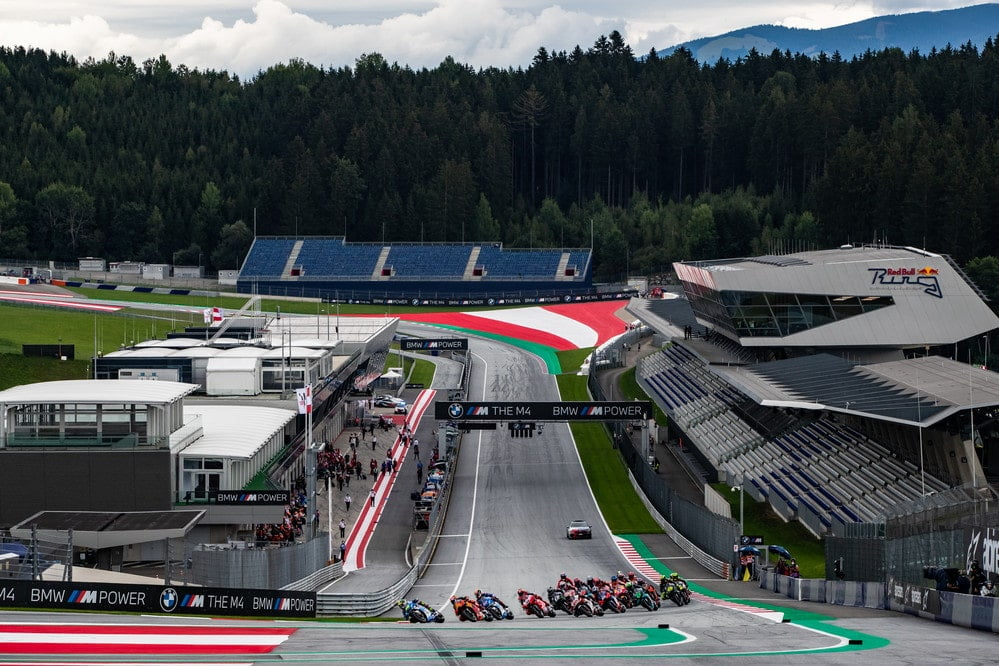
Whilst the stewards’ reasoning for penalising Martin and not Espargaro is unclear, it is possible that they also viewed the situation with Espargaro as a particular one, since it is the final corner of the race. As we have seen in the past, with Valentino Rossi and Sete Gibernau; Marc Marquez and Jorge Lorenzo in Jerez; or with Rossi and Marquez in Assen, final corners can often exist in their own parameters compared to the rest of the race.
Fifth place for Andrea Dovizioso is a remarkable change from the dominant win he took one week previously, but the 11 points are important nonetheless, and he closed to within three points of the championship lead.
Alex Rins took sixth place, after a poor start from the Suzuki rider left him behind Valentino Rossi and Takaaki Nakagami. Just as in the first race, where Rins was stuck behind the KTM of Espargaro, the #42 paid the price of having difficulty in overtaking. Behind Rins was a disappointed Nakagami in seventh place, ahead of Brad Binder who dropped from the back of the lead battle to eighth after running wide at turn one, Valentino Rossi who managed Yamaha’s lack of straight line speed and brake issues well enough for ninth place and top YZR-M1, and Iker Lecuona who took his first top 10 in MotoGP.
Danilo Petrucci was 11th, ahead of Aleix Espargaro; Fabio Quartararo who suffered a lot with brakes and paid for a bad start; Johann Zarco who benefitted from the red flag as it gave him chance to rest his broken scaphoid; and Franco Morbidelli who struggled to one point on his Yamaha.
Alex Marquez was just outside the points in 16th, ahead of Cal Crutchlow and Stefan Bradl. The three 2020 RC213Vs finishing outside the points when the 2019 bike was fast enough for the podium indicates the backwards step Honda has taken in 2020. Behind them was Bradley Smith, ahead of Michele Pirro and Tito Rabat who was the final finisher in 21st.



![Private: [ID: 71rYi-xncgM] Youtube Automatic](https://motorradio-xijqc.projectbeta.co.uk/wp-content/uploads/2024/08/private-id-71ryi-xncgm-youtube-a-1-360x203.jpg)
![Private: [ID: 1SfHxvC8Doo] Youtube Automatic](https://motorradio-xijqc.projectbeta.co.uk/wp-content/uploads/2024/07/private-id-1sfhxvc8doo-youtube-a-1.jpg)
![Private: [ID: H6XRkf6kROQ] Youtube Automatic](https://motorradio-xijqc.projectbeta.co.uk/wp-content/uploads/2024/07/private-id-h6xrkf6kroq-youtube-a-1-360x203.jpg)
![Private: [ID: Kb6w-qAmKls] Youtube Automatic](https://motorradio-xijqc.projectbeta.co.uk/wp-content/uploads/2023/12/private-id-kb6w-qamkls-youtube-a-360x203.jpg)
![Private: [ID: CcpwYw20k3k] Youtube Automatic](https://motorradio-xijqc.projectbeta.co.uk/wp-content/uploads/2024/07/private-id-ccpwyw20k3k-youtube-a-360x203.jpg)

![[ID: x1SiRC5jhW4] Youtube Automatic](https://motorradio-xijqc.projectbeta.co.uk/wp-content/uploads/2022/04/id-x1sirc5jhw4-youtube-automatic-360x203.jpg)
![[ID: lMZ8lAeLubk] Youtube Automatic](https://motorradio-xijqc.projectbeta.co.uk/wp-content/uploads/2022/04/id-lmz8laelubk-youtube-automatic-360x203.jpg)
![[ID: GAYCcnqyFo4] Youtube Automatic](https://motorradio-xijqc.projectbeta.co.uk/wp-content/uploads/2022/04/id-gayccnqyfo4-youtube-automatic-360x203.jpg)
![[ID: Gg142H296QY] Youtube Automatic](https://motorradio-xijqc.projectbeta.co.uk/wp-content/uploads/2022/04/id-gg142h296qy-youtube-automatic-360x203.jpg)
![Private: [ID: 71rYi-xncgM] Youtube Automatic](https://motorradio-xijqc.projectbeta.co.uk/wp-content/uploads/2024/08/private-id-71ryi-xncgm-youtube-a-1-236x133.jpg)
![Private: [ID: H6XRkf6kROQ] Youtube Automatic](https://motorradio-xijqc.projectbeta.co.uk/wp-content/uploads/2024/07/private-id-h6xrkf6kroq-youtube-a-1-236x133.jpg)
![Private: [ID: Kb6w-qAmKls] Youtube Automatic](https://motorradio-xijqc.projectbeta.co.uk/wp-content/uploads/2023/12/private-id-kb6w-qamkls-youtube-a-236x133.jpg)
![Private: [ID: nc-8g6ROCe8] Youtube Automatic](https://motorradio-xijqc.projectbeta.co.uk/wp-content/uploads/2023/11/private-id-nc-8g6roce8-youtube-a-236x133.jpg)
![Private: [ID: wWrhfjOQuIc] Youtube Automatic](https://motorradio-xijqc.projectbeta.co.uk/wp-content/uploads/2023/11/private-id-wwrhfjoquic-youtube-a-236x133.jpg)